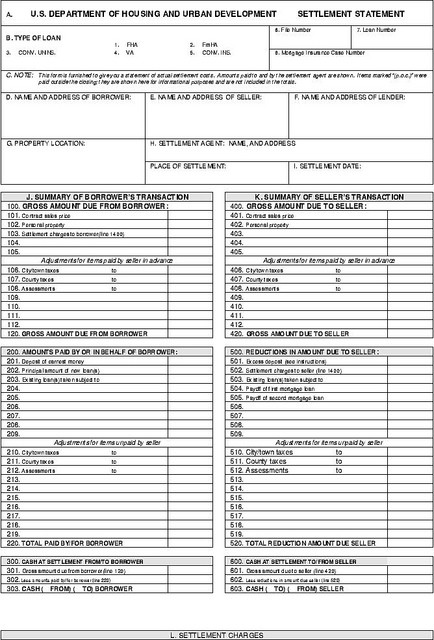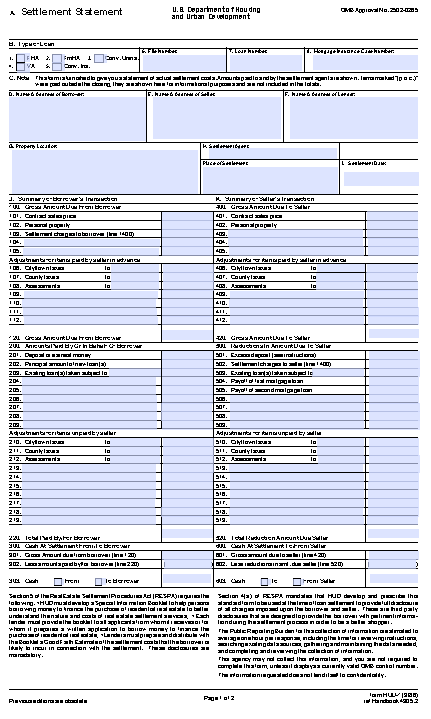HUD1 Closing Statement Borrowers Guide
Post on: 1 Июнь, 2015 No Comment

Closing Costs » HUD-1: A Borrower’s Guide
A pile of paperwork thuds onto the closing table at any home sale or refinance. One of the key documents is a government-mandated settlement statement that dissects the costs of the deal. It also assures borrowers that they are receiving the loan they agreed on. Whether you buy, sell or refinance, you get this form, called the HUD-1.
Depending on local customs, buyers, sellers and borrowers might receive more than one estimated HUD-1 prior to closing, so they can track new information and changes as the loan progresses. The last HUD-1 might not be issued until the transaction has been closed and recorded, and all of the charges and prepaid interest are known to the last penny, according to Phyllis Yanagihara, a certified senior escrow officer at Master Escrow in Glendale, Calif.
It’s pronounced hud one. The name refers to the U.S. Department of Housing and Urban Development, which introduced the current version of the form in January 2010.
Download a copy of the HUD-1 in PDF format. Here’s a look at the form’s main sections:
Basic information about the loan
Sections B through H of the settlement statement describe parameters of the transaction, including the name and address of the buyer, seller and lender, the property address, the name of the settlement company, and the closing date.
Borrowers should pay attention to the loan type, suggests Kimberly Green, operations director at Quicken Loans in Detroit.
If you’re signing up for an FHA (Federal Housing Administration-insured) loan, you want to make sure that first box that’s checked is FHA, whereas if you think you’re getting a conventional loan and the FHA box is checked, definitely question it, she says.
Summaries of borrower’s and seller’s transactions
Section J summarizes the buyer’s or borrower’s costs. The figures in the so-called 100 series are sums due from the buyer or borrower, with line 120 being the total. The 200 series figures are amounts credited to the buyer or borrower, with line 220 being the total. The 300 series pulls the totals from line 120 and 220 to calculate line 303, the total amount due to or from the buyer or borrower at closing.
Section K shows sums due to the seller in the 400 series, reductions in the amount due to the seller in the 500 series, and the total amount due to or from the seller in the 600 series.
Some states require separate settlement statements for the buyer and seller while other states allow both sides to be shown on one statement, Green explains.
If you’re a buyer and the seller side is blank, it’s not a concern, she says.
Settlement charges
This section, on Page 2, contains the 700 series of real estate brokerage fees, 800 series of lender fees, 900 series of prepaid charges (such as interest and mortgage insurance), 1000 series of escrow (or impound) deposits, 1100 series of title insurance fees, 1200 series of government recording fees and transfer taxes, and 1300 series of other settlement charges. The last is a catchall used for such miscellaneous expenses as a home inspection or pest control report.

Escrow deposits, if any, are set aside by the lender to pay the buyer’s or borrower’s property taxes and homeowners insurance premiums. Green says lenders typically collect a cushion in case the amounts increase, but they aren’t allowed to pad the account.
You want to make sure there are sufficient funds to be able to pay those (expenses) when they’re due, she says.
Comparison of Good Faith Estimate (GFE) and HUD-1 charges
Page 3, on which this section appears, is the best page and the most important for borrowers, Green says. The first column in the top three sections recaps the Good Faith Estimate, or GFE, which discloses the buyer’s or borrower’s loan charges. The second column recaps the HUD-1 charges, allowing a line-by-line comparison of the estimates to the actual costs.
The total, shown at the bottom of the second chart as both a dollar amount and percentage, discloses the difference between the GFE and HUD-1 with respect to costs that can’t increase at all or can’t increase by more than 10 percent. If the lender miscalculated or didn’t properly disclose these charges, a refund must be issued to the buyer or borrower for the overage, Yanagihara explains.
It does happen on occasion, she says.
Loan terms
The final section recaps the terms of the loan, including the initial loan amount, interest rate, monthly payment of principal, interest and mortgage insurance, if any, and loan term. The questions and check boxes disclose whether the rate can rise, whether the loan balance or payment can increase, and whether the loan has a prepayment penalty or balloon payment. Further details should be noted if any of the yes boxes are checked.
2013 Closing Costs Survey Mortgage closing costs are up again in Bankrate’s annual study.














